Cochise Marble – A Surprise in the Arizona Desert
by Karin Kirk
Photos Courtesy Cochise Marble;
Map and Graphic by Karin Kirk
Among sweeps of tan, red, and grey rocks, sits a surprise: A pocket of gleaming white marble.
Even the geologic map makes barely a passing mention of it – but the stone is a spectacular find that rewards those who look deeper.
The Legacy of Minerals
Cochise Marble quarry is located near Bowie, Arizona, in the Chiricahua Mountain range. The region is the ancestral lands of Apache tribes, and was acquired by the United States from Mexico in 1848. American military expeditions, surveyors, and prospectors set out to explore the territory, striking gold in the Chiricahua Mountains in 1860.
Decades of struggle ensued, writing more chapters in the ages-long battle between resource extraction and indigenous people that has been repeated throughout history. Though it’s a difficult part of our American story, the Cochise Marble company tries to honor the origins of the land and the people who lived here before us. The crew operates with a light touch on the landscape with goal to diligently use all materials extracted from the land.
Cochise County, named after the revered Apache Chief, has derived much of its prosperity from ores and minerals. The area has been home to gold, silver, copper, lead, and zinc mining. These metallic deposits were formed when molten magma melted its way through older sedimentary layers. Fluids circulating through the hot rocks concentrated the metals, which eventually solidified into veins within the rock.
The heat from the magma had another effect — it warmed up the surrounding rocks, causing localized changes that are too small to appear on most geologic maps. Near the crest of the Chiricahua mountains, the Escabrosa limestone was heated and recrystallized, changing it from a sedimentary rock to a metamorphic one, and transforming 300-million-year-old marine limestone to a white marble of rare quality.
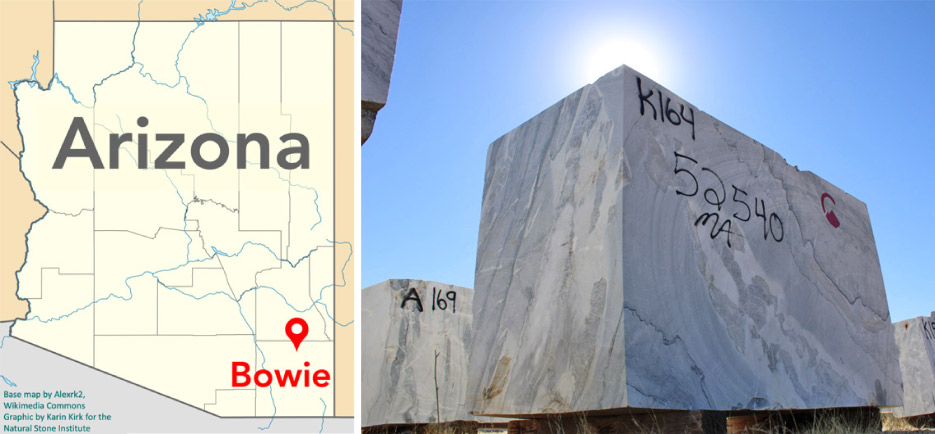 |
‘Are you sure that’s from Arizona?’
Camden Mueller, marketing manager for Cochise Marble, recalls a common occurrence. People look at our stone and say, “Oh is this Italian?” Camden recalls one anecdote at a trade show, when he explained the stone is from Arizona. An onlooker exclaimed, “I live in Tucson! There’s no way. That’s impossible.” Camden is accustomed to having to explain the unlikely stone, having done it many times before. “So I showed her a video. I said, ‘No, here it is, look! I promise I’m not pulling your leg.’”
Josh Gonzalez, a co-owner at the company, picks up the story from there. “I think people expect more of the brown colors that you see out here. They’re like, ‘Oh, it’s Arizona, western, it’s the desert, there’s no way there’s marble.’” Josh describes the frequent questions: “ ‘Is that 100% marble?’ And we’re like, ‘Yes, it’s 100% marble.’” Josh breaks into a laugh as he replays the conversation.
“Are you sure?”
“Yes, I’m sure.”
“Has it been tested?”
“Yes, it has.”
The element of surprise is an obvious source of pride. It hints at the uniqueness of the quarry and the commitment of the company to bring Arizona marble to a market that might not expect it.
 |
|
Arizona’s desert landscape is famous for its shades of the sunset. Cliffs, canyons, and mesas of russet orange and tawny brown have become icons of the American Southwest. |
‘Let’s start digging’
Marco Gonzalez is involved with strategic planning for the company. He’s also Josh’s uncle. Marco has logged more than 30 years working with stone. “I love it every day,” he says. Marco, Josh, and Camden shared the story of the origins of the quarry, beginning in 1908.
Josh muses, “Sometimes you wonder, like, back in 1908 who said, ‘Oh, right here. Marble. Let’s start digging.’”
The original quarry operated for around thirty years, and like so many historical quarries, it shut down, sitting idle for over six decades. In 2002, a local businessman and cattle rancher named Matt Klump set his eyes on reopening the quarry. At the time, the quarry was owned by a family in Texas, who didn’t even realize they owned it. Josh explains, “Matt approached them and said, ‘Hey – you guys own this quarry.’ And they’re like, ‘We own a quarry?’”
The Klump family purchased the quarry and created the Arizona Marble Company. Matt then built a partnership with Josh and Marco to launch Cochise Marble, LLC. Matt is an integral part of the operation. “We’re all active in this quarry,” says Marco. “We all work together.”
Bringing the quarry back to life took about two years. “We knew that there was an investment for us to work our way into this quarry,” Marco recalls. “Once we decided we were ready – and that was about eighteen to twenty-four months into it – the investment was in place, we had all the right equipment, the right personnel – that’s when we went to market.”
But starting from scratch is an uphill climb. “Did the projects just come flowing in? No,” says Marco.
“We have to go out there. Hence the reason that Camden is working for us in marketing and merchandising.”
After a few years building their inventory and forging new networks, the company now has traction in commercial projects. Business is steady, and Cochise marble will be part of a four-year long, commercial project that will be the company’s largest contract to date.
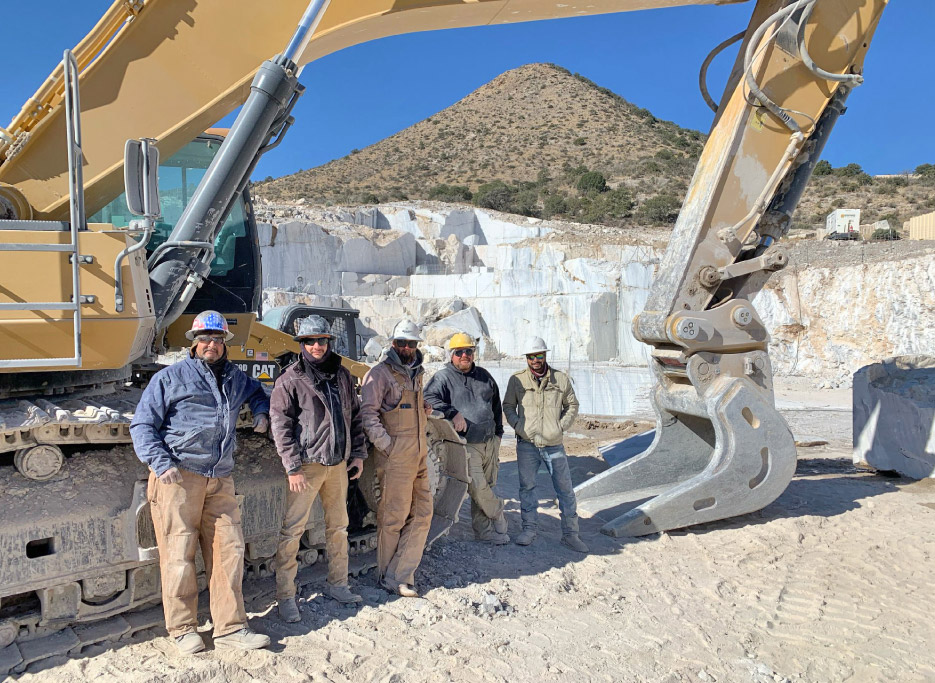 |
| Hidden beneath the rolling landscape is a treasure trove of exotic marble. |
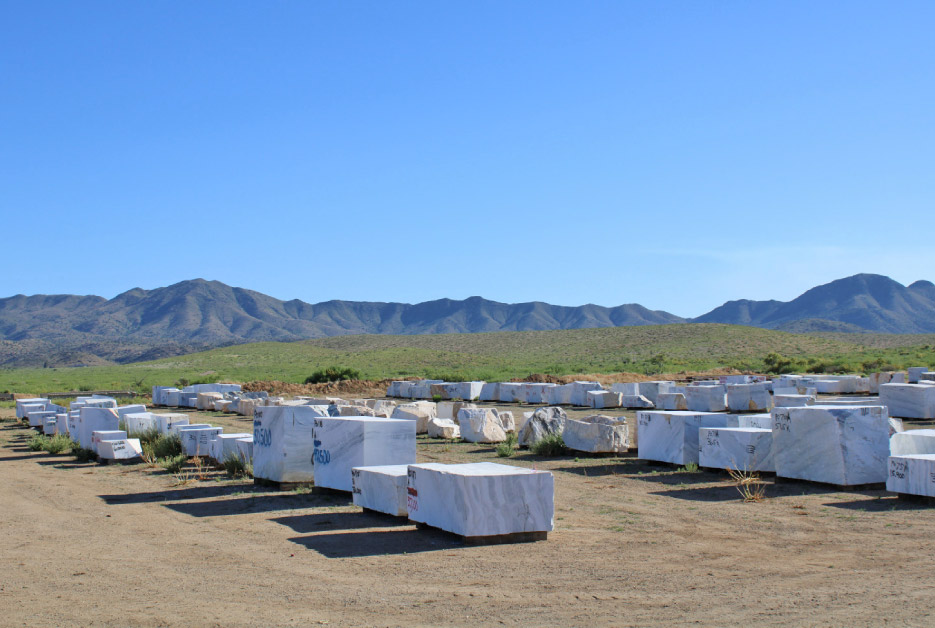 |
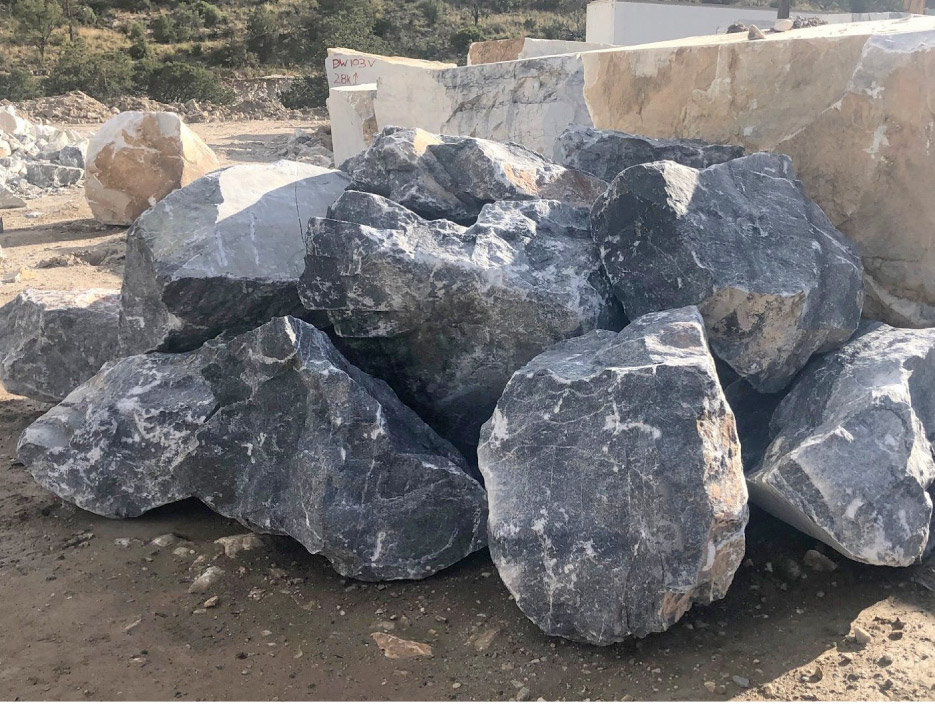 |
|
Cochise marble blocks and boulders ready for slicing and polishing. |
An Ethos of Efficiency
“One thing to say about Matt,” says Camden. “He is the one who really instilled the idea of using every single piece of marble.”
Blocks and slabs are the high-profile quarry products, but smaller pieces are cut into veneer, and leftover remnants are crushed into gravel. “But then it even gets finer than that,” says Camden. When gravel is crushed down, some sand is produced. White sand is used for decorative planters and as an ingredient in cement. The 99% purity of the marble means it can be processed into a refined powder for adhesives and pigments.
“So, from the sand to the block … every piece is being used,” says Camden.
“It’s environmental,” Marco adds. “For us it’s not only business. It helps our environment.”
A locally-derived product is another way to trim one’s environmental impact. Moreover, rising fuel prices and bottlenecks in the global supply chain make a domestic stone all the more appealing. “We are getting more inquiries because people want to buy American,” says Marco.
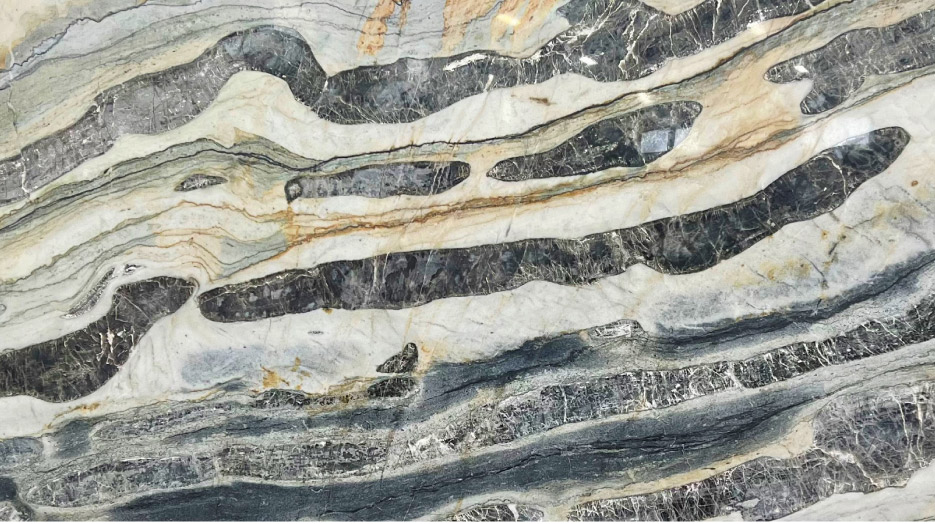 |
|
Above: American Caviar marble – a very unique multi-colored stone found Below: A Fire pit fashioned from an American Caviar boulder rests on |
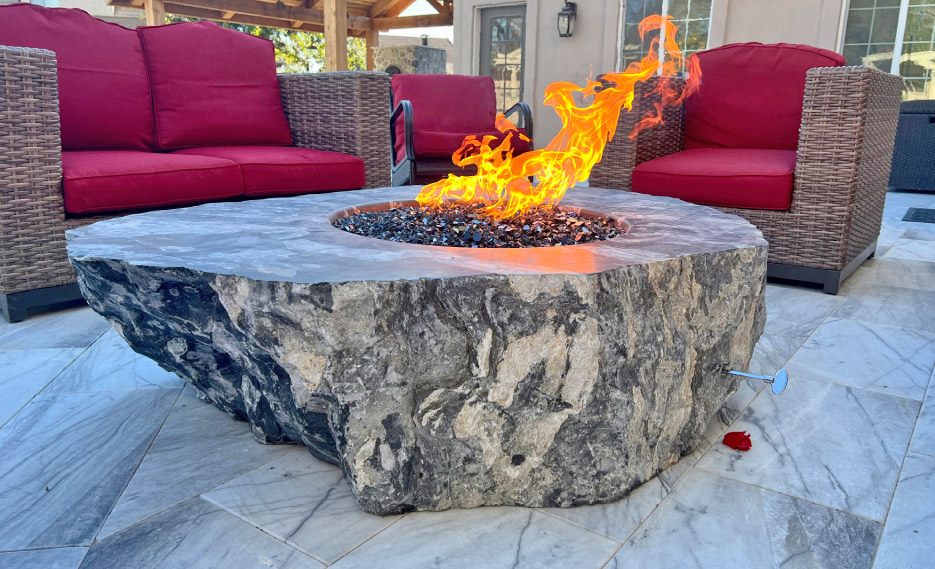 |
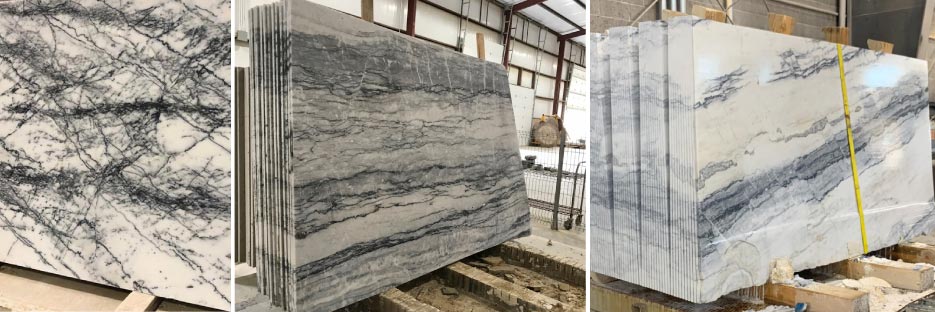 |
|
Above, left: Geronimo White marble, polished slab. Above, middle: Apache Grey honed slabs. Above, right: Apache Select White, polished slabs. |
 |
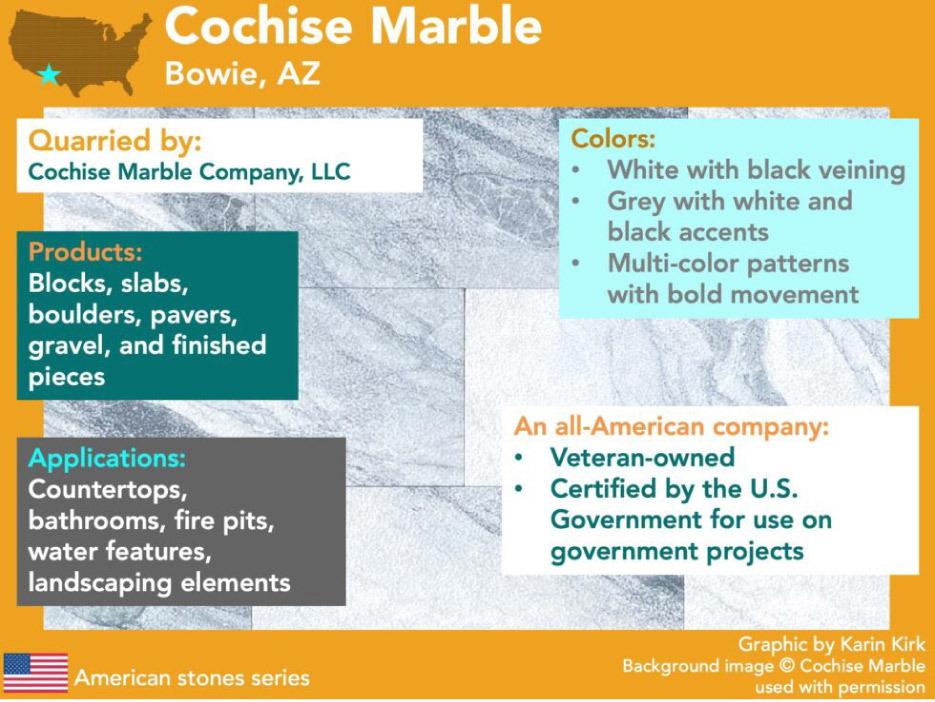 |
Quarry Taking Shape
The team describes the company’s vision and roadmap for the stages of quarry development. The Cochise crew hired a master quarrier from Europe to help them assess the rock layers. “He did his due diligence on the quarry,” says Marco, which allowed the team to move ahead with their plan and begin quarrying.
Currently, the company is cutting blocks from the same general area that was originally worked 100 years ago. This horizon contains white, black, grey, and multi-colored marble. ‘Cochise White’ is a pure white marble with subtle veining, lending an airy, ethereal vibe to the stone.
A little higher on the hillside is another set of ledges that contain white marble and a grey-blue marble.
Higher still, there’s one more deposit. Marco describes it: “The very top is where we have a very, very unique stone. It’s a beautiful white marble. The background is similar to the statuary marble out of Italy, with black veining.” In honor of the Apache warrior who dedicated his life to protect his homeland, the marble is named Geronimo. “It will take us some months where we have a steady supply of it,” says Marco, with a mixture of pride and anticipation.
Camden picks up the storyline from there, “We have another unique stone — the signature stone. And our master quarrier when he first saw the stone, he stood on top of it and he called it ‘caviar.’ It has about six colors in it. So we named it ‘American Caviar.’ It’s a stone that is only found in one place in the world.”
American Caviar is a blend of dark grey calcite marble with layers lenses of light grey, silica-rich chert. Chert is a common ingredient of limestone, and it forms as small accumulations of nearly pure silica on the sea floor. The silica hardens into oval-shaped layers or rounded nodules, and they tend to stand out from the limestone in both color and texture. When the Escabrosa limestone was transformed into marble, the original pattern remained, giving the stone a large-scale spotted appearance. Hence, the caviar name. American Caviar offers a bold pattern that works as a landscape feature or as dramatic bookmatched slabs.
A Creative Approach
Camden credits some out-of-the-box thinking that helped them bring their products to market. “It comes down to a little bit of our creativity,” he says. “As a marble quarry everybody expects slabs, stair treads, pavers, things like that. But we’ve really brainstormed to bring new products to the market.” The company offers firepits, water features, and textured paving stones. “Those aren’t things that you see every day,” says Camden. When people see products crafted from this southwestern marble, Camden describes their reaction as “amazing.” He continues, “They’re so excited to see this. And it’s just been a domino effect where people say, ‘Oh my gosh – I want one!’”
The exploration of new products from an unlikely stone is a fitting example of the intricacies of geology – from a huge planet, we find joy in small and beautiful details. All the better when it surprises us.
For more information visit Cochisemarble.com .